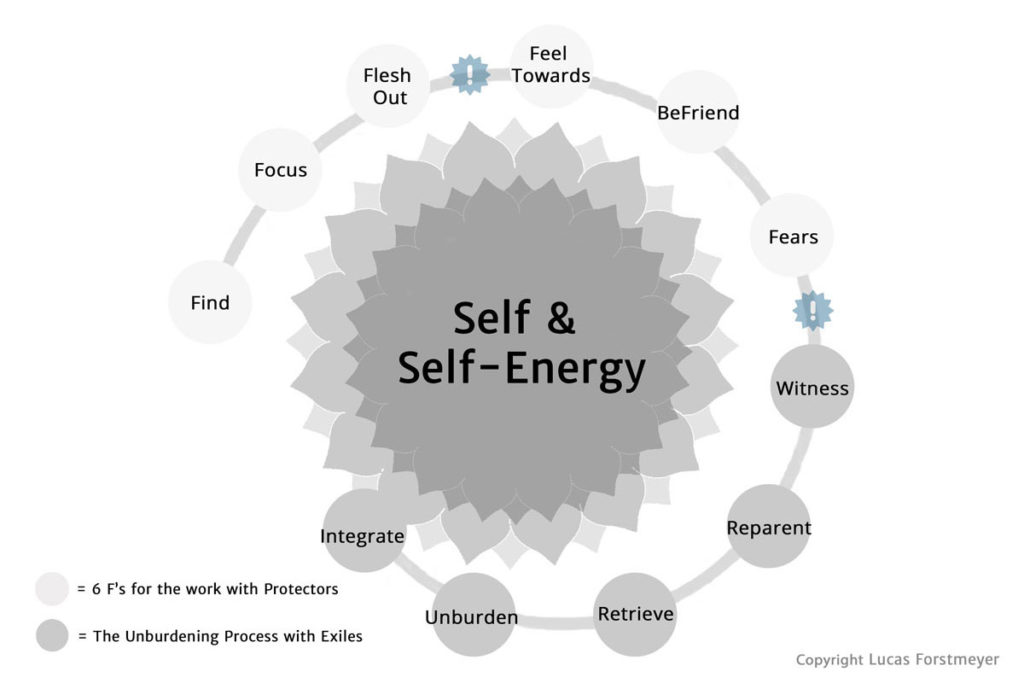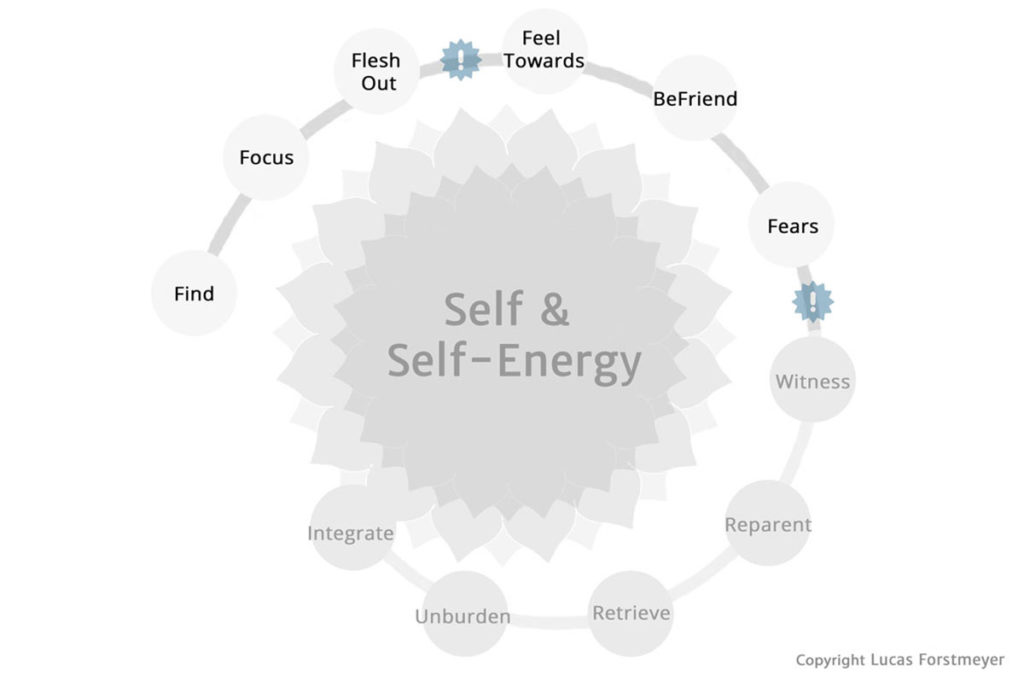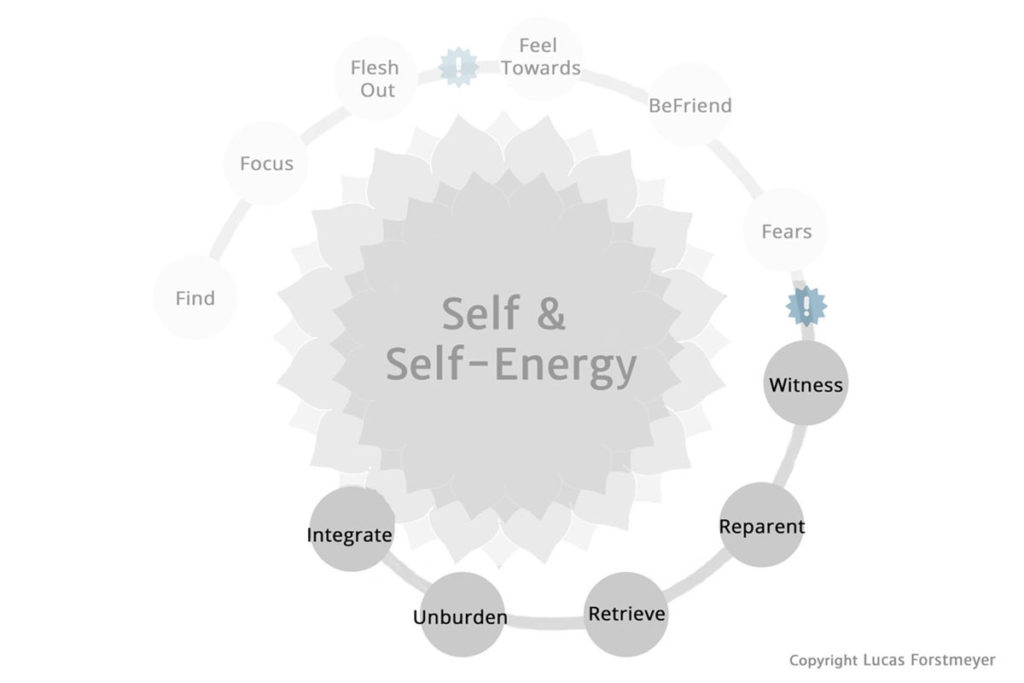This article offers an introduction to the Internal Family Systems Therapy. For this it covers the most important Steps and Questions used in the IFS-Approach.
IFS or Internal Family Systems is both a model of our mind and psyche and an approach to therapy.
Both the model and approach work with the assumption that each person has many Parts (subpersonalities) and that these parts strongly influence (sometimes even determine) how one feels and acts in the world.
In addition, IFS asserts that each person has a Self (an essential/spiritual core) that is not a Part and that is inherently compassionate, calm and open.
The IFS-Model gives a map for different parts, relationships between parts and interactions with the Self. The IFS-Approach gives practical tools on how to work with Parts and support the Self to be more present.
The ‘Steps of the IFS-Approach’ are the steps of the therapeutic process IFS uses to work with parts that are creating problems in a person’s life. In essence, these steps are about helping the Self and these parts to re-connect and empowering the person’s Self to help his or her own Parts.
These steps are used both by Therapists to support their Clients and people working with themselves to develop more compassion and empowerment to support themselves and their own Parts.
The rest of this article is an overview of these Steps. For this I first want to introduce a diagram I developed (open for constructive feedback):

A few general points on these steps and this diagram:
The 6 F’s are the IFS-Steps for working with Protectors (Parts that actively do – sometimes very distorted – things to try and protect a person from harm and keep them functioning in life).
The basic goals of the 6 F’s are

FIND: Finding out with which topic and Parts we work AND then localising the part in or around the body.
↓
FOCUS: Focusing the attention inwards on the Part. Learning a bit about it and its qualities.
↓
FLESH OUT: Learning more about the Part in a way that supports the separation between Part and Self.
↓
FEEL TOWARDS: Testing the Presence of Self, unblending from the Part if necessary to establish a strong connection between Self and Parts.
↓
BEFRIEND: Learning more about the Part and establishing a good relationship between Self and Part.
↓
FEARS: Asking about the deepest fears of the part that influence it to act the way it does. Usually this points towards exiles and polarized parts.
The Unburdening-Process covers the steps that have emerged within IFS to help Exiles to let go of a Burden (old pain and unprocessed emotions) they are carrying – and often have carried for years or decades.
This process includes the Self being present with and holding the Exile in their pain, helping them have a new experience and supporting them in letting go of the old pain they have been carrying.
PLEASE BE AWARE: Being with Exiles is delicate work.
Exiles are simultaneously fragile and holding very intense emotions and experiences. So trying to “just unburden” an exile is both dangerous and ungracious. Going to these old places without appropriate skills or support by a person who can hold you and the Exile can lead to the system becoming more charged and activated.
So if an Exile keeps coming up in you: please get the help that is appropriate.

CONTACTING EXILE: Establishing a connection between the Self and Exile in which the Self can be present with the experience of the exile.
↓
WITNESSING EXILE: Inviting the Exile to show anything it wants to show so it can be seen, felt and understood – in what happened and how that made it feel.
Additionally: Supporting the Exile in understanding that this happened in the past.
↓
REPARENTING EXILE: Allowing the Exile to have a new experience. Either in the memory of the past OR in the present.
↓
RETRIEVING EXILE: Freeing the Exile from the situation of the past and bringing it into a better situation in imagination or the present.
↓
UNBURDENING EXILE: Holding a ritual in which the Exile can let go of the Burdens it has been holding.
↓
INTEGRATING EXILE AND PROTECTOR: Finding a good place for both Exile and protector in the system and life.
Also: Integrating the qualities of Being that are arising in you.
I hope this helps you to either get an idea of the IFS-Process or deepen your understanding and practice with these Steps.
If you have any questions or remarks, feel free to get in touch.
| Cookie | Duration | Description |
|---|---|---|
| cookielawinfo-checkbox-advertisement | 1 year | Set by the GDPR Cookie Consent plugin, this cookie is used to record the user consent for the cookies in the "Advertisement" category . |
| cookielawinfo-checkbox-analytics | 11 months | This cookie is set by GDPR Cookie Consent plugin. The cookie is used to store the user consent for the cookies in the category "Analytics". |
| cookielawinfo-checkbox-functional | 11 months | The cookie is set by GDPR cookie consent to record the user consent for the cookies in the category "Functional". |
| cookielawinfo-checkbox-necessary | 11 months | This cookie is set by GDPR Cookie Consent plugin. The cookies is used to store the user consent for the cookies in the category "Necessary". |
| cookielawinfo-checkbox-others | 11 months | This cookie is set by GDPR Cookie Consent plugin. The cookie is used to store the user consent for the cookies in the category "Other. |
| cookielawinfo-checkbox-performance | 11 months | This cookie is set by GDPR Cookie Consent plugin. The cookie is used to store the user consent for the cookies in the category "Performance". |
| elementor | never | This cookie is used by the website's WordPress theme. It allows the website owner to implement or change the website's content in real-time. |
| PHPSESSID | 1 month | This cookie is native to PHP applications. The cookie is used to store and identify a users' unique session ID for the purpose of managing user session on the website. The cookie is a session cookies and is deleted when all the browser windows are closed. |
| viewed_cookie_policy | 11 months | The cookie is set by the GDPR Cookie Consent plugin and is used to store whether or not user has consented to the use of cookies. It does not store any personal data. |
| Cookie | Duration | Description |
|---|---|---|
| CONSENT | 2 years | YouTube sets this cookie via embedded youtube-videos and registers anonymous statistical data. |
| Cookie | Duration | Description |
|---|---|---|
| VISITOR_INFO1_LIVE | 5 months 27 days | A cookie set by YouTube to measure bandwidth that determines whether the user gets the new or old player interface. |
| YSC | session | YSC cookie is set by Youtube and is used to track the views of embedded videos on Youtube pages. |
| yt-remote-connected-devices | never | YouTube sets this cookie to store the video preferences of the user using embedded YouTube video. |
| yt-remote-device-id | never | YouTube sets this cookie to store the video preferences of the user using embedded YouTube video. |
| Cookie | Duration | Description |
|---|---|---|
| device_id | 2 years | No description available. |